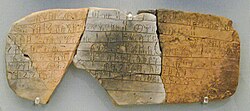
But doesn't a Linear B imply a Linear A?
Well, yes, it does, and it looks like this:

Can't make head nor tail of it?
No, neither can anyone else.
There are a few things we do know about Linear A. It was used in the second millennium BC in Crete. It was first written about by Sir Arthur Evans, who excavated the ruins at Knossos and also happened to live in the same street in the same Hertfordshire town as me (though not at the same time. Well, he died in 1941.).
Evans called the script linear because it's made up of, er, lines, as opposed to the little pictures familiar from hieroglyphs.
Linear A uses hundreds of signs. About fifty of them are quite like Linear B, which can be read, but about 80% of Linear A's signs are quite different from anything else.
No one has much of a clue what any of it means. People are even still arguing about what language Linear A represents - some sort of Greek, Hittite-Luwian, Phoenician, Indo-Iranian or Tyrrhenian.
Ah well. Whatever it says, if it's anything like other ancient languages then the chances are that most of the inscriptions are tax returns.
And, lets face it, anyone sane does their best to avoid those even when they're in plain English.
Word To Use Today: linear. This word comes from the Latin word līneāris, which means to do with lines.
No comments:
Post a Comment
All comments are very welcome, but please make them suitable for The Word Den's family audience.